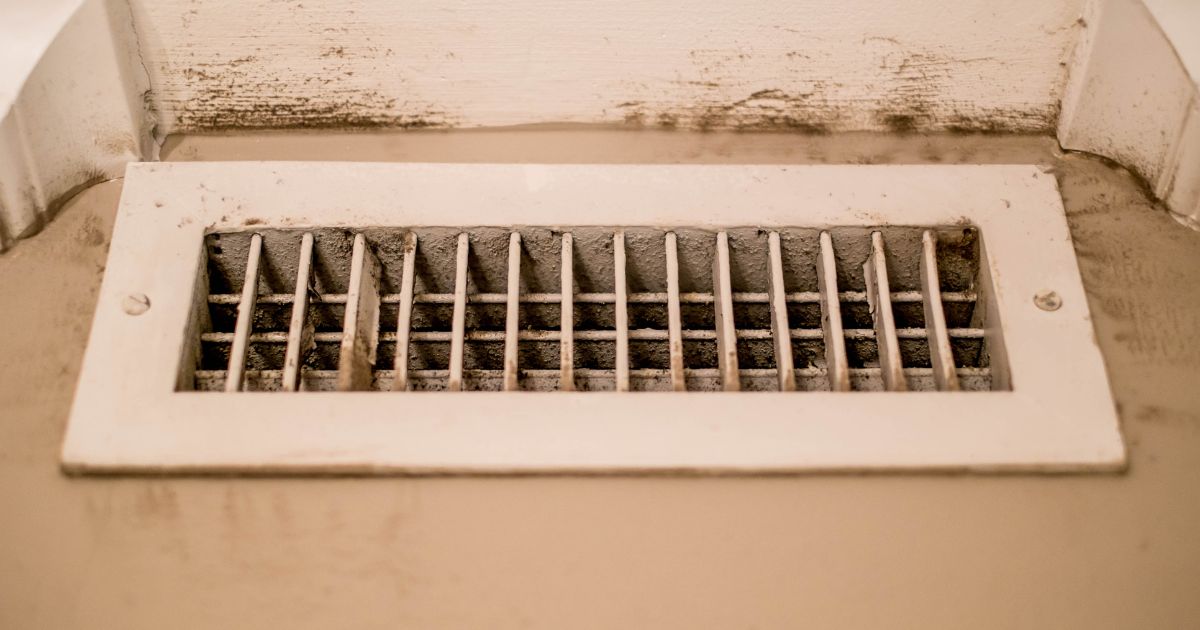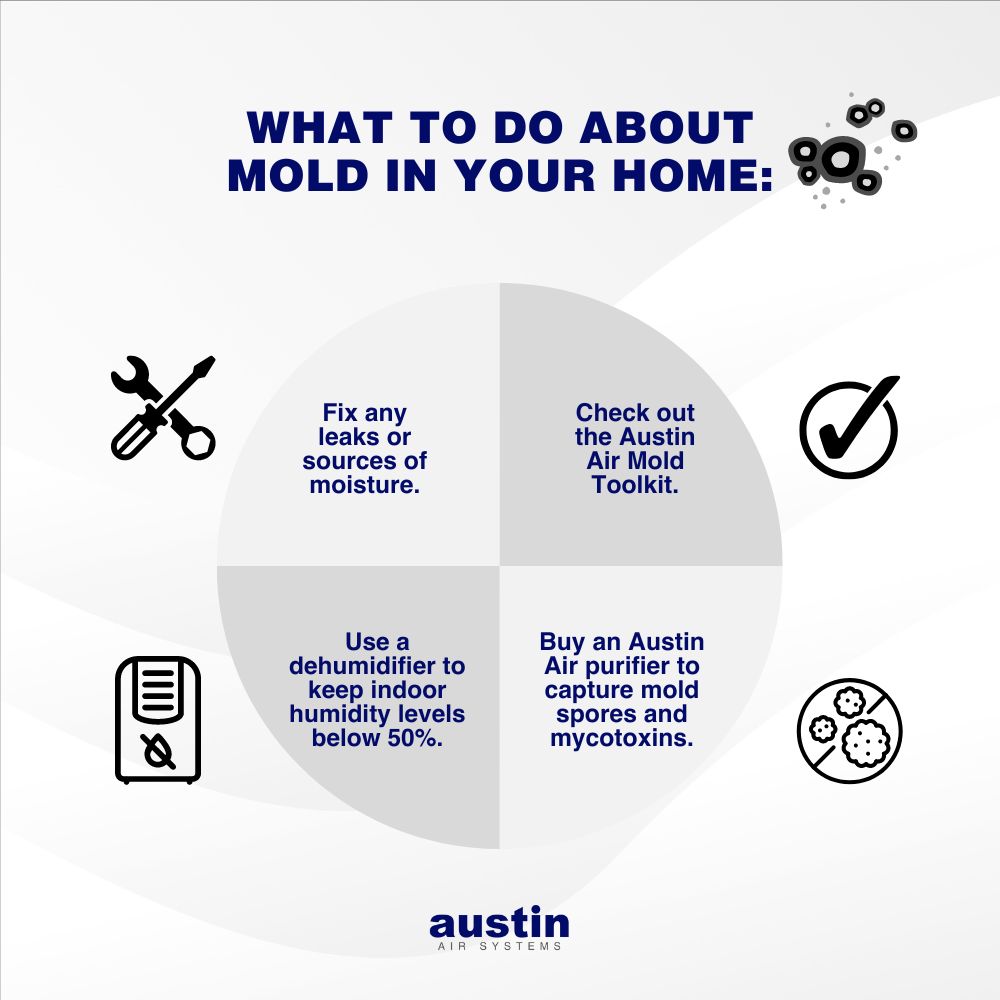How to Spot Dirty Air in Your Home: Key Signs and Solutions
While we often think of air pollution as something happening outdoors, indoor air is often even more contaminated – sometimes 100x more polluted!1 But how do you know if the air in your home is dirty? If you look closely, you can often “see” dirty air with a careful eye for a few tell-tale signs.
PROBLEM #1: Moisture and Mold
Mold is one of the most visible and harmful signs of poor air quality. Mold thrives in moist environments. So if you notice mold growth around windows, bathrooms, or in your basement, it’s a clear indication of high humidity levels. Black spots on the walls, ceilings, or grout are also warning signs.
Breathing in mold can be dangerous because mold spores release allergens, irritants, and even toxic substances known as mycotoxins into the air. When inhaled, these particles can trigger allergic reactions, asthma attacks, respiratory issues, and in severe cases, long-term exposure may lead to more serious conditions like chronic lung inflammation, infections, or even neurological problems. Mold is particularly harmful to individuals with weakened immune systems, young children, and the elderly.
What to do:
- Fix any leaks or sources of moisture.
- Use a dehumidifier to keep indoor humidity levels below 50%.
- Consider an Austin Air Purifier to capture mold spores and mycotoxins.
- Check out the Austin Air Mold Toolkit to learn more about mold remediation.
PROBLEM #2: Dirty Vents and HVAC Filters
Take a look at your vents and HVAC filters. If you notice layers of dust or grime, it’s a sign that your air system isn’t circulating clean air. Dirty filters spread allergens, dust, mold, pollen, and other harmful particles throughout your living space, aggravating asthma, allergies, and other respiratory conditions. Regular cleaning and proper maintenance help improve indoor air quality, reducing the risk of respiratory issues and ensuring a healthier living environment.
What to do:
- Change HVAC filters regularly (at least every three months).
- Clean vents periodically and make sure they’re not blocked by furniture.
- Invest in a high-efficiency Austin Air Purifier to support cleaner air in your home.
PROBLEM #3: Smoke Stains
If you or someone in your household smokes, or if you frequently cook indoors, check the walls and ceilings near stoves or smoking areas. This can also be an issue for people living in apartment buildings, with neighbors or previous tenants who smoke. Yellowish-brown stains from cigarette smoke or cooking can linger, indicating poor ventilation and trapped smoke particles in the air.
Austin Air Systems has partnered with Johns Hopkins University Hospital in multiple studies, two of which examined health outcomes for people exposed to cigarette smoke. The first study showed significant improvements in indoor air quality for pregnant women and women with young children living with smokers, with 98% recommending Austin Air purifiers.
A 2021 study focused on people with COPD found that using Austin Air purifiers dramatically reduced pollution levels, leading to improved symptoms and reduced medication use, particularly for those spending more time indoors. These studies highlight the health benefits of Austin Air’s technology for those exposed to smoke and airborne pollutants. If someone in your home or apartment building is exposing you to smoke, you have options.
What to do:
- If you smoke, quit as soon as possible (we have to try to be a positive influence) or smoke outside.
- Increase ventilation by using fans or opening windows.
- Use an air purifier specifically designed to target smoke, like the Austin Air HealthMate Plus, which features a carbon filter impregnated with potassium-iodide to reduce airborne gases and odors.
PROBLEM #4: Dust Buildup
If you notice an excess of dust accumulating on surfaces, particularly in rooms that are frequently used, this is often a sign that particles like skin cells, pet dander, and other pollutants are circulating in the air.
Dust is more than just a nuisance to folks who are allergic, a buildup of dust in your home can still pose health risks. Dust particles often carry pollutants like bacteria, mold spores, chemicals, and even microscopic pests. Breathing in these particles over time can irritate the respiratory system, leading to coughing, sneezing, or more serious issues like bronchitis or asthma.
Prolonged exposure may also weaken the immune system, making it harder for your body to fight off infections and other health problems. Maintaining a dust-free environment is important for everyone’s overall respiratory health.
What to do:
- Dust and vacuum regularly.
- Close windows during nearby construction or increased farming activity like spring planting.
- Minimize clutter, such as knick-knacks, to reduce the number of items that can accumulate dust.
- Place mats at entryways to catch dust and dirt before it enters your home.
- Dust mites thrive in bedding, so wash sheets, pillowcases, and blankets frequently.
- An Austin Air Purifier can trap fine particles, helping reduce dust and dander in your living space.
By recognizing these signs of dirty air and taking simple actions, you can significantly improve your home’s air quality. Using a portable air purifier, like those from Austin Air Systems, ensures a healthier living space with fewer pollutants circulating in the air. Make sure your home looks, smells, and feels clean—starting with the air you breathe!
REFERENCES
1 Taking an exposure history: What are possible sources of indoor air pollution (2015 June 23). US CDC Agency for Toxic Substances and Disease Registry. https://www.atsdr.cdc.gov/csem/exposure-history/Indoor-Air-Pollution-Sources.html.


![Infographic about “What to do for healthy air with an HVAC system,” with the title written in royal blue in all caps, with a line of three graphics connected to each suggestions by a line of royal blue dots: Change HVAC filters regularly (at least every three months) [linked to a graphic showing two arrows in a circle), Clean vents periodically and make sure they’re not blocked by furniture [linked to a graphic of three diamonds to represent a “sparkling clean”], and Invest in a high-efficiency Austin Air purifier to support cleaner air [with a graphic of wind]. The words: “Austin Air Systems” are located in the bottom center in royal blue.](https://austinair.com/wp-content/uploads/2024/09/what-to-do-for-a-healthy-HVAC-system.jpg)
